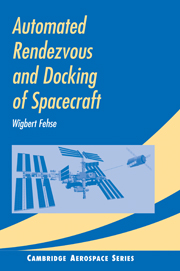Book contents
- Frontmatter
- Contents
- Preface
- List of symbols
- 1 Introduction
- 2 The phases of a rendezvous mission
- 3 Orbit dynamics and trajectory elements
- 4 Approach safety and collision avoidance
- 5 The drivers for the approach strategy
- 6 The onboard rendezvous control system
- 7 Sensors for rendezvous navigation
- 8 Mating systems
- 9 Space and ground system setup
- 10 Verification and validation
- Appendix A Motion dynamics
- Appendix B Rendezvous strategies of existing vehicles
- Appendix C Rendezvous vehicles of the ISS scenario
- Glossary
- References
- Index
9 - Space and ground system setup
Published online by Cambridge University Press: 13 October 2009
- Frontmatter
- Contents
- Preface
- List of symbols
- 1 Introduction
- 2 The phases of a rendezvous mission
- 3 Orbit dynamics and trajectory elements
- 4 Approach safety and collision avoidance
- 5 The drivers for the approach strategy
- 6 The onboard rendezvous control system
- 7 Sensors for rendezvous navigation
- 8 Mating systems
- 9 Space and ground system setup
- 10 Verification and validation
- Appendix A Motion dynamics
- Appendix B Rendezvous strategies of existing vehicles
- Appendix C Rendezvous vehicles of the ISS scenario
- Glossary
- References
- Index
Summary
This chapter addresses the tasks and responsibilities of all parties outside the automatic onboard system involved in the control of a rendezvous mission. It looks at the hierarchy of authority, the support functions required and the constraints imposed by the communication links. Tasks and design principles of support tools for human operators are indicated.
As discussed already in chapter 6, in an Earth orbit there is no need to conduct the rendezvous and docking process fully autonomously. The interaction by external operators is, on the contrary, always desirable, when this will reduce the complexity of the system and increase safety and success probability. On the other hand, because of the limitations of the communication links, the complete control of the rendezvous and docking process cannot be performed entirely from ground. For this reason, the onboard control system of unmanned spacecraft must be able to perform automatically in the vicinity of the target vehicle the control tasks discussed in chapter 6:
the control of the spacecraft state (attitude angles, position, velocities and angular rates);
the sequencing of manoeuvres and modes at the right time and points of a trajectory;
the detection of, and recovery from, anomalies and failures;
in the case of docking, sequencing and control of mating operations.
A number of high level control tasks can be performed better by remote human operators, who can contribute the human capabilities of recognition and assessment of unpredicted situations, together with the much larger resources for information gathering and data processing than are available to the onboard system.
- Type
- Chapter
- Information
- Automated Rendezvous and Docking of Spacecraft , pp. 336 - 361Publisher: Cambridge University PressPrint publication year: 2003



